Do you want to make healthier choices when you shop?
Do you want to know what the real meaning of 'natural', 'organic', 'light', 'low GI' and 'Gluten Free' is?
Here are some quick tips to make your shopping easier!
| Ingredient List: All ingredients for food products are listed in order from largest to smallest by weight. If fat, sugar, or salt are listed in the first three ingredients, the food is usually not a healthy choice. Fats, sugars, and salt are often listed using various different names:
|
- Other names for sugar: dextrose, fructose, glucose, golden syrup, honey, maple syrup, sucrose, malt, maltose, lactose, brown sugar, caser sugar, raw sugar, sucrose
- Other names for salt: baking powder, celery sat, garlic salt, meat / yeast extract, monosodium glutamate (MSG), onion sat, rock salt, sea salt, sodium, sodium ascorbate, sodium bicarbonate, stock cubes, vegetable salt, sodium nitrate / nitrite
How to read the Nutritional Information Panel:
At the very top it tells you how many serves are in the package and the recommended serving size.
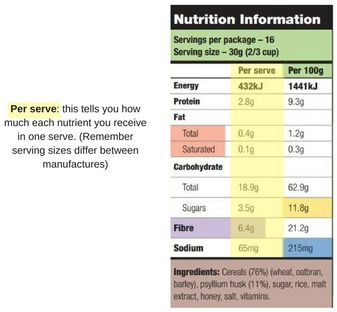
If you want to lose weight the number you really want to look at is Energy.
Choose the lowest energy product out of similar foods. Higher kilojoules may contribute to more weight gain. It is better to avoid discretionary foods as they provide few nutrients but lots of kilojoules, but it is still possible to include small serves occasionally. Use this number to help you decide if this food is really ‘kilojoule worth’
Total fat: less than 10g per 100g
Choose the lowest fat product out of similar foods; for milk, yoghurt and ice-cream, choose less than 2g per 100g, and for cheese, choose less than 15g per 100g
Saturated fat, which is the bad fat contributes to cardiovascular disease: aim for less than 3g per 100g
Sugar: less than 10g per 100g; or up to 20-25g per 100g if fruit is listed before sugar in the ingredient list (*people with diabetes need to take carbohydrate into account as well, not only added sugar)
Dietary fibre: aim for more than 3g fibre per serve (*people with IBD need to be careful about fibre)
Sodium (salt): less than 400mg sodium per 100g (*people with high blood pressure, liver disease and kidney disease may require no added salt diet)
The Healthy Star Rating System
· It is a voluntary system so not displayed on the all packages.
· You have to compare like for like i.e. Don’t compare a bag of chips with bread
· The rating is based on an algorithm. The product gets points for good nutrients (vitamins, minerals, fibres, protein, and antioxidants), but loses point for bad nutrients (kilojoules, saturated fat, sodium, and sugar).
For example water gets a poor result using this rating because there are no ‘good nutrients’, however there are no bad nutrients either. Some juice could have 5 star rating, but it doesn't mean we should choose juice rather than water as juice is often very high in sugar. Water is always the best option to keep hydrated.
Nutrition Claims
‘Low Fat’ VS ‘Reduced Fat’: ‘low fat’ is a better claim as it tells you that the food is definitely low in fat (<3g/100g for solid food, or <1.5g/100g liquid food); ‘reduced fat’ contains at least 25% less fat than in the same quantity of reference food, but it could be still high in fat
‘Cholesterol Free’: doesn’t mean fat free, oils derived from plants are all cholesterol free
‘No Added Sugar’: it is true, but may still be high in natural sugar, such as juice
Products carrying ‘low fat’ claims may be very high in sugar, not low in total energy, so it is still important to look at the Nutrition Information Panel.
Some claims could be deceptive and misleading.
‘Light’ / ‘Lite’: this may describe the taste, texture, colour, fat, salt or sugar content. It doesn't mean it could help lose weight
‘Natural’: this doesn’t always mean the food is a good choice. Ingredients such as animal fats, cream, and sugar are all ‘natural’, but not necessarily healthy.
‘Baked Not Fried’: it is true, but they usually have a lot of fat added during the process. Remember to check the fat content in the Nutrition Information Panel.
‘Organic’: it is true, however may not necessary be more nutritious or healthier. E.g.: organic chips is still not a healthy food.
Reading food labels can be time consuming when you're starting out and requires some practice, but it is definitely worth your time! Remember it’s an investment in your heath, and what price can you put on that!
The above information acts as a general guideline, however everyone is different with different dietary goals, intolerances and lifestyles. If you would like personalised nutritional advice, help with meal plans, meeting your goals or further information on how 'to be a smarter shopper', book an appointment with our Dietitian and Nutritionist Daiqing (Grace) Yu today on 08 8296 7594.
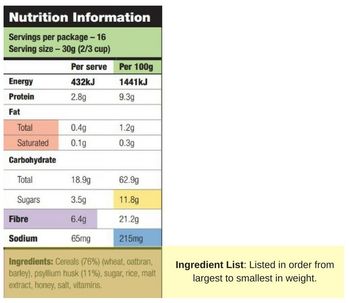
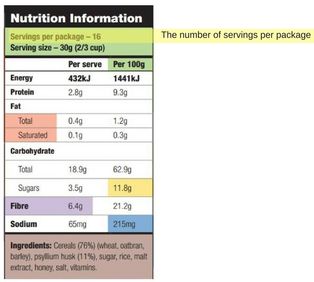
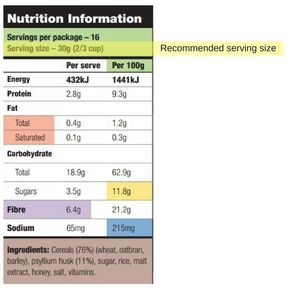

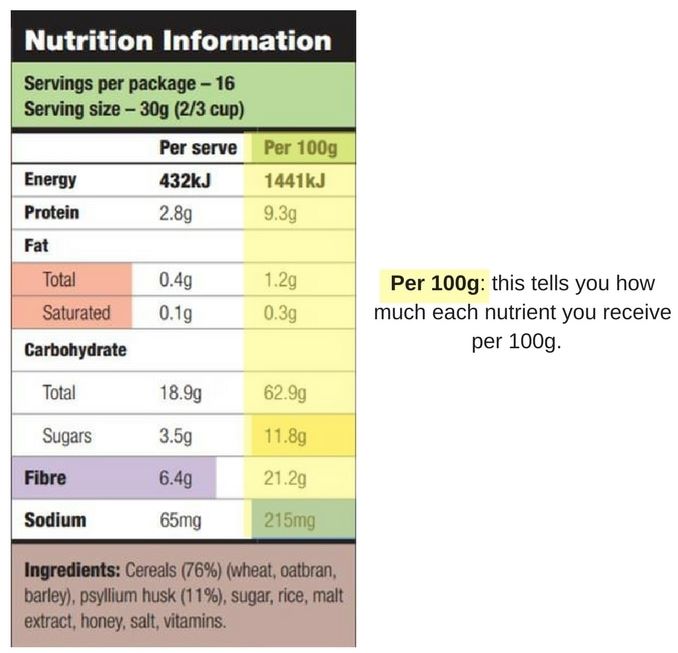

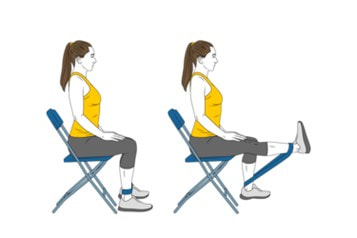
 RSS Feed
RSS Feed